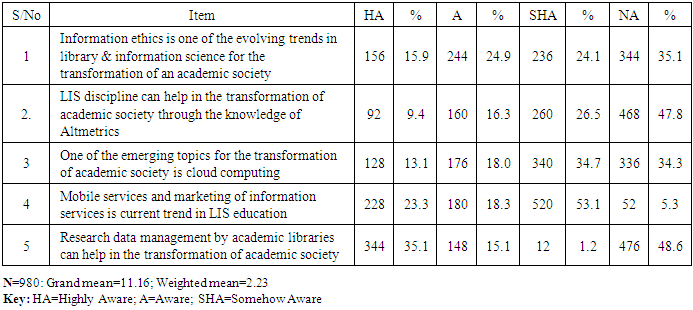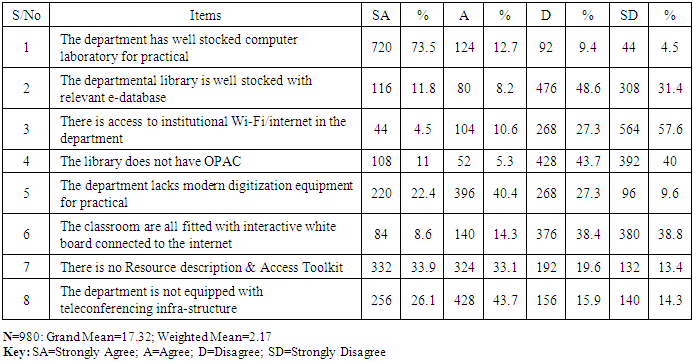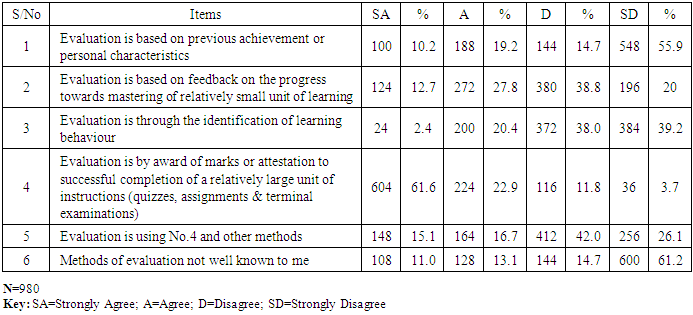-
Paper Information
- Next Paper
- Paper Submission
-
Journal Information
- About This Journal
- Editorial Board
- Current Issue
- Archive
- Author Guidelines
- Contact Us
International Journal of Library Science
p-ISSN: 2168-488X e-ISSN: 2168-4901
2020; 9(3): 57-70
doi:10.5923/j.library.20200903.02

State and Students’ Understanding of Library and Information Science Education in Universities in Southeast Nigeria
Onwubiko Emmanuel Chidiadi
Acquisitions Librarian, Alex Ekwueme Federal University, Ndufu-Alike, Ikwo, Nigeria
Correspondence to: Onwubiko Emmanuel Chidiadi, Acquisitions Librarian, Alex Ekwueme Federal University, Ndufu-Alike, Ikwo, Nigeria.
| Email: |  |
Copyright © 2020 The Author(s). Published by Scientific & Academic Publishing.
This work is licensed under the Creative Commons Attribution International License (CC BY).
http://creativecommons.org/licenses/by/4.0/

This is an empirical study on the State and Students’ understanding of Library and information Science Education in Universities in Southeast Nigeria.The main objective of this study is to find out current library and information science educational procedure in SE Nigeria as to determining how it holistically prepare potential librarians towards the changes that are taking place in our environment as a result of the birth of ICT. The research employed a descriptive survey design with a sampled population of 980 LIS students from four accredited universities in SE Nigeria. In analyzing the data, SPSS output format based on simple frequency count and percentage distribution, mean and standard deviation were used. The result of the study proves that: there is low awareness among LIS students on emerging topics in LIS in the SE Nigeria; teaching pattern is mainly theory than the application of theory and practical. The result also shows that there are modern facilities but there are no RDA toolkits, functional ICT laboratories and effective internet services. The study also discovered that there is no room for students to evaluate their lecturers neither are the three domains in education generally considered in the final evaluation of students.
Keywords: Librarianship, Library and information science, Education, Students, Curriculum, Southeast Nigeria
Cite this paper: Onwubiko Emmanuel Chidiadi, State and Students’ Understanding of Library and Information Science Education in Universities in Southeast Nigeria, International Journal of Library Science, Vol. 9 No. 3, 2020, pp. 57-70. doi: 10.5923/j.library.20200903.02.
Article Outline
1. Background of the Study
- The practice of librarianship constitutes holding out oneself as skilled in the knowledge, art and services of the organisation, dissemination, preservation of recorded information, the reading, the rendering, furnishing and contracting of professional services such as consultation and advice on the organisation and management of libraries; data-banks, research and information centres to client on a fee or otherwise; the teaching of subjects in the library and information; and the signing or authenticating for clients of document and reports when called for (Chanrobles, 2019). This implies that the sole aim of librarianship is to provide the needed information to library users and so to speak to the society. If one looks at what constitutes librarianship as indicated above, one can deduce that librarians by training are moulded and equipped with the technique on how to acquire, process, organise, store and disseminate the needed information to the community. They are also provided with the skills to provide services that meet the needs of the community through information education, preservation of cultural heritage and recreation. The above skills can only be obtained through LISE. LISE in Nigerian Universities have a great deal of autonomy regarding their curricula and are able to review these, provided funding and time permit. Library and information Science is controlled by National University Commission (NUC) whose main vision is: ‘To be a dynamic regulatory agency acting as a catalyst for positive change and innovation for the delivery of quality university education in Nigeria and functions as: Granting approval for all academic programmes run in Nigerian universities; Granting approval for the establishment of all higher educational institutions offering degree programmes in Nigeria; Ensure quality assurance of all academic programmes offered in Nigerian universities; and Channel for all external support to the Nigerian universities’. and Librarians Registration Council Nigeria (LRCN) whose mission is: ‘To pursue the attainment of professional excellence by determining who are librarians; set standard of knowledge and skills required for registration and practice; guidelines for accreditation and minimum standards for libraries, and maintenance of professional discipline among librarians’ and the mandate to: ‘Determine the level of knowledge and skill required to be a librarian and Set and maintain standards for all categories of libraries by maintaining discipline within the LIS profession’ (NUC, 2020 and LRCN, 2019).The two bodies regulate and fund (or solicits funds) for curriculum reviews and applies quality assurance procedures governing the university educational system. All LIS education and training programmes in the SE Nigeria follow a common curriculum, developed in collaboration with university faculty staff as directed by NUC the sole body that is responsible for programme accreditation in any Nigerian university. On the other hand, education in librarianship had its debut in SE Nigeria in 1983 when the Department of Library Science, as it was originally known, was created in University of Nigeria, Nsukka as a response to repeated calls for more training opportunities for library and information professionals in the region. Subsequent changes in the name of the Department and degree nomenclature (from B.A.L.S/B.SC.L.S. to B.L.I.S.) were effected to reflect current trends. As Adebayo and Alex-Nmacha (2018) posit, a major significance of information is its capability to reduce uncertainty, sustain planning and as an instrument for decision making. The underlined fact is that librarians and libraries as information managers and disseminators are looked upon as society reformers and as agents of change as nothing changes ones mindset like information. It is believed that a society that is not well informed remains under-developed. To this end, a certified librarian no matter where he finds himself is expected to provide the desired information that can touch and change the community for good. In the Nigeria context, much is expected of the librarians in a community that is surrounded by uncertainty and requires tremendous transformation. The crux of the matter is that the academic society is the most wanted area for this change and transformation as the centre of learning, research and character building. There is therefore this need for library and information science education to be tailored towards preparing would-be librarians with the desired skills and knowledge as to be relevant in this dynamic world.
2. Statement of Problem
- The societal change which also affected library and information science definitely calls for a paradigm shift in the education and skills acquisition of potential librarians. For the librarians of today and tomorrow to remain relevant and contribute meaningfully in the transformation of the academic society and Nigeria’s societies, there should be a total overhauling of the educational curriculum of library schools in Nigeria as to enhancing effective training of potential librarians.A critical analysis of literature reviewed, observations, and interactions with undergraduate of library and information science revealed that students are not aware of emerging topics in their field of study; it revealed also that the current educational process and training are mainly theory-based than practical. A study by Anderson (2007) in Australia stipulates that LIS education programmes are blamed for producing graduates who lack the requisite skills to function effectively in the society. In the United States of America, Moran and Marchionini (2012) confirm this criticism, asserting that LIS graduates fail to meet the immediate needs and requirements of current LIS work environments. The general criticism has heightened pressure on LIS education and training programmes globally and, particularly in SE Nigeria, to empower graduates with generic skills enabling them to contribute to their future places of employment and ‘perform successfully as citizens in the knowledge economy. Furthermore, there is this critical decay in modern infrastructure and equipment for training librarians as obtained in advanced countries and students are only evaluated by terminal examinations divulged of any form of practical. This situation was also exposed by Munyoro (2014) in his study that LIS education and training programmes in most countries of Africa have not significantly responded to changes in the profession, in wider society, and in higher education globally, by reviewing and updating. Virkus (2012) points out that a curriculum is the best barometer for measuring changes in the profession and in society at large. Burnett (2013) concludes that LIS curricula in Nigeria are out-dated and are of only limited use in today’s transient work environments. The criticisms suggest a widening gap between the needs of society and LIS education and training systems. There is therefore, an urgent need for an in-depth empirical study into the quality of LIS education, to define gaps in LIS curricula and to suggest ways of empowering students to fulfil the demands made on graduates as society transformation agents.If the problem under study is not addressed, LIS education and training programmes will stray from their principal mission of producing skilled human capital for the society and the profession. The relevance and ultimately the survival of the LIS academic discipline are in other words, under threat. It is the consideration of the above challenges that this sort of study becomes necessary with the aim of investigating the state and students’ understanding of library and information science education in universities in South-East Nigeria and by extension- Nigeria. Scope of the StudyThe scope of this study is all accredited universities in the South East Nigeria offering library and information science at undergraduate levels (100 – 400 level). The universities include: Abia State University, Uturu (ABSU); Imo State University, Owerri (IMSU); Nnamdi Azikiwe University, Awka (NAU) and University of Nigeria (UNN).Objectives of the studyThe specific objective of this study is to establish the State and Students’ understanding of Library and information Science Education in Universities in Southeast Nigeria.Generally, the objectives are to:1. Determine library and information science students’ awareness of emerging topics in library and information science education;2. Identify educational processes being used in the training of library and information science students in universities in the South East Nigeria;3. Evaluate as to establishing the state of educational infrastructure and equipment that are available for the training of library and information science students in universities in the South East Nigeria,4. Identify the methods by which library and information science students in the South East Nigeria are being evaluated.Research Questions The present study seeks to address the following research questions:1. Are library and information science students in universities in South East Nigeria aware of emerging topics in library and information science education?2. What educational processes are used in the training of library and information science students in universities in South East Nigeria?3. What educational infrastructure and equipment are available for the training of library and information students in universities in South East Nigeria?4. What methods are used in evaluating students of library and information science in universities in South East Nigeria?
3. Literature Review
- Librarianship as a profession that is skilled in knowledge, arts and science of the organisation, preservation and dissemination of recorded information to stand the test of time must through her training schools continue to raise generations in line with the changing world. This implies that for librarians and libraries to still remain relevant in the scheme of things and also be appreciated, there must be a paradigm shift on activities being used for training of library and information science students in line with the constant changes in the environment. Mills, Campana and Goldsmith (2017), also shared the above view as they posit that in the face of changing landscape of information services, library and information science education can push the field of librarianship forward by adopting research based frameworks that are directly applicable to the profession. The above suggests that the traditional theoretical methods of training librarians are not in tandem with the changing environment.The study of Kacunguzi and Samuel (2016), which assessed Nigeria and Uganda’s Library and information programmes in meeting the demand of the digital age, reported that library and information science as a discipline in Africa is continuously struggling to keep up with diverse platform through which it can satisfy the demands of the job market. In the study, four LIS programmes in East and West African countries were assessed in order to know if they align with the professional demands of librarians in the changing information environment. With a comparison similar to LIS programmes in the US, the final analysis shows that all the four programmes considered in Nigeria and Uganda were not adequately inclusive; the schools in Nigeria were even far from achieving digitally attractive library curricula. The study recommended that Nigeria needs to improve on the technology and electronic information management contents of their curricula to replicate the 21st century skills required of librarians. In the same vein, Nalumaga (2016) carried out a survey on trends and development in information schools (ischools) in Africa. The report shows that the movement from traditional library schools to ischools reflects a revised approach towards librarianship and information technologies. The report also revealed that an examination of library and information schools across Africa that only one has formally adopted the ischool perspective. This submission explains that there is urgent need for changes in the infrastructure; curriculum, contents and process of LIS education for the transformation of academic society. Stating the obvious, for some institutions, embracing a modern identity and disciplinary approach, may be a matter of survival knowing that man is susceptible to change.According to Kaluli and Mutula (2017), the redefining of library and information science education and training in Zimbabwe is structured to close the workforce skills gap. In their study, they identified gaps in knowledge as well as in functional and generic employability training in LIS curricula. The gaps according to them are connected to the transient environment in which LIS departments operate; outdated educational models; shortage of well developed multi-stakeholders, mutual partnership and alliance; an expanding labour environment and absence of continuous professional development programmes. From the result, one can deduce that not only Zimbabwean, but African LIS education programmes as a whole need a holistic transformation through the adoption of innovative education models that can meet the dictates of the techno-economic standard that serves today’s society. One can also conclude from the submissions that there is need for the training of academic librarians to align with the modern changes in the academic society.Lowden et al., (2011) suggest that multidisciplinary competencies such as project management, communication and presentation, pedagogy and skills related to technology, business, planning, designing and general management are integral to efficient work flows and service provision in the transitory LIS labour environment. Pettigrew (2013) and Gibbs et al. (2011) shift the focus from multidisciplinary abilities to the need for knowledge of information ethics. According to these authors, LIS professionals need to have an in-depth understanding of information- related laws and ethical issues pertaining to intellectual property rights (IPR) such as copyright laws, information access, rights to information, privacy protection and open access. The Economist Intelligence Unit (2014) report for the British Council stirred the focus of the discourse to technical skills associated with specific jobs. The remark is that LIS professionals ‘must be able to tell the library’s story through various media-writing, photography, audio and video. Partridge et al. (2010) share this view, arguing that LIS work environments require a librarians with well-developed functional skills for the use and application of information technology in library operations, to compare, evaluate and select technologies and software, translate print-based services to electronic services, design and manage websites, engage with and use technology to accomplish professional tasks.In his study of the past, present and future of LIS education in Anglophone Africa from colonial period to the present, Otike (2017), discovered that earliest schools were initially known as library schools and later changed to LIS schools after independence. The curricula were based on programme prevailing in the mother countries. he further exposed the fact that LIS schools are rapidly increasing all over the continent but noted that if not checked could have a severe consequences on the quality of graduates being produced. He concluded by saying that LIS schools need to match the rapid changes taking place in the information industry and societies with process of preparing and producing information professionals. The nature of employability skills in today’s labour environments is indicative of the radical changes taking place in the world and related to the techno-economic paradigm serving contemporary society. This techno-economic paradigm demands a workforce with multidisciplinary expertise, highly developed functional skills and a myriad of personal attributes (Munyoro, 2014). To facilitate the development of such competencies and qualities in library science graduates, LIS education and training programmes globally have reformed and reoriented their curricula. Multi- and trans-disciplinary and ICT-related modules and subjects have been integrated into study offerings and curricula are continuously being revamped to align them with the demands of the labour market (Munyoro, 2014). Prebor (2010) and Kovatcheva (2011), observe that today’s LIS education programmes have absorbed courses ranging from computer science, education, communication and media studies to business management, technology, sociology, anthropology, psychology, political science, information systems, natural sciences and law. Minishi-Majanja (2007), reviewing efforts to integrate ICT into LIS curricula, found that LIS schools in sub-Saharan Africa have indeed incorporated diverse ICT modules in their curricula as a strategy to prevent curriculum drift, to improve the quality of programmes and to realign them with labour environments needs and demands. Some LIS departments have recreated curricula by no longer focusing exclusively on the traditional library functions rather letting their institutions play a more broadly-based role in the provision of information access (Chu, 2010). Other departments have changed the titles of their programmes, for example from Library Science to Library and Information Science, or Studies/Management, or Information Science/Studies/Management/Knowledge Management, as a strategy to ‘embrace diversification and clustering into larger organisational groupings’ (Raju, 2013). Raju (2013) observes that LIS departments in South Africa and a few other parts of the world are jostling with related disciplines, offering advanced programmes such as media studies, computer science, informatics, information systems and business information management. Lowden et al. (2011) point out that LIS departments have introduced work-integrated learning projects, job shadowing and internships as institutional responses to the demands of labour environments. In addition, they have introduced professional seminars and critical inquiry as new modules and made them into core courses. These courses are aimed at developing such general employability skills requirements as in leadership, communication skills and the ability to think critically and creatively, to work in a team and to be enterprising as the courses attempt to empower students by combining teaching with practice through group projects, peer learning, presentations, online discussions and peer evaluation of project work (Chaudhry et al., 2008). Similarly, LIS professional bodies such as the International Federation of Library Associations (IFLA), the Chartered Institute of Library and Information Professionals (CILIP), the American Library Association (ALA) and the Special Libraries Association (SLA) have responded to concerns expressed by the LIS job market by developing competency frameworks. These frameworks explicitly accentuate the knowledge and the various competencies and employability skills that those wishing to enter the profession should acquire (Rehman, 2012).Writing on students’ evaluation method, Adebayo and Alex-Nmacha (2018) opine that since education is a process, outside awarding marks after examinations, LIS schools should find a unified ways of evaluating students’ cognitive, affective and psychomotor skills.The literature is broadly in agreement that worldwide, the LIS community of practice finds itself in the midst of a radical transition. This is attributed to socio-economic and technological factors such as changing modes of information production, storage and dissemination, changing patterns of economic competition, as well as new forms of work organisation, technological innovations and an intensifying consumerism that has resulted in increasing needs of users who expect information services to be not only technically competent, but also conveniently delivered.
4. Methodology
- Research DesignThe research employed descriptive survey research design which according to Nworgu (2015) is a type of study which aims at collecting data on describing in a systematic manner the characteristics features and facts about a given population. This design gave the researcher the room for proper description and analysis of data collected. Area of StudyArea of study is universities in Southeast Nigeria accredited to offer undergraduate programmes in LIS leading to the award of BLS, BLIS, BA/ BSc Education/LIS etc. These universities are spread in the five States of the region which are: Abia; Anambra; Ebonyi, Enugu and Imo State. The mentioned states cover the geo-political zone called South Eastern Nigeria with each housing one federal and state owned university respectively. Imperatively, there are 10 government owned universities in the region but of the 10, only 4 have accredited LIS schools. The universities are: Abia State University, Uturu (ABSU); Imo State University, Owerri (IMSU), Nnamdi Azikiwe University, Awka (NAU) and University of Nigeria, Nsukka (UNN).Population of StudyThe population of this study comprises all the 300 and 400 levels students of the Department of Library and Information Science of the schools under study. They were chosen based on the fact that they are familiar with all the topics taught in their departments.The Sampled PopulationPopulation for this study is 980 LIS students from the four universities under study. To derive this number, a total enumerative sampling technique was applied. This technique according to Sharma (2014) is a sampling technique in which every subject meeting the criteria of inclusion is selected until the required sample size is achieved. This census method of sampling implies that all the undergraduates of LIS Schools under study were respondents.Instrument for Data CollectionThe principle instrument used for data collection is a structured questionnaire formulated in line with the research objectives. The instrument consist of ‘section A’ that sought the demographic information of the respondents, while ‘section B’ contains items/statements that focused on the research questions developed in line with the study objectives. The researcher also used observation/document analysis which gave the researcher an insight to the curricula contents and interview with which data were collected on the state of library graduates from the university librarians of participating library schools. A document review checklist was developed, based on Bloom’s (1984) taxonomy of learning domains: cognitive, affective and psychomotor and guided by the research question: Are library and information science students aware of emerging topics needed for the transformation of academic society in South East Nigeria? The outcomes for each course outline were delineated. The checklist was used to systematically assess LIS curricular documents and course outlines and to ensure that valid information was identified (World Bank Institute (WBI) Evaluation Group, 2007). And after which, each identified course outline and curricular documents were analysed and coded with the obtained data documented. Assisted by a research assistant and Heads of Department of LIS of the schools, the questionnaires were directly administered to the students and returned 100%. In analyzing the data collected, SPSS output format based on simple frequency count, percentage distribution, mean, standard deviation and Pearson’s Chi-Square were used with data presented in figures and tables. Prior to using the instrument for study proper, it was subjected to a validity and reliability test. A test-retest method was used to collect data from 90 students used in trial testing. Cronbach Alpha was used to determine the reliability which gave a reliability coefficient of 0.87.
5. Data Presentation
- The data collected for this study is here presented in figures and tables; with the figures showing the demographic data of the respondents and the tables showing data in respect of the research questions.
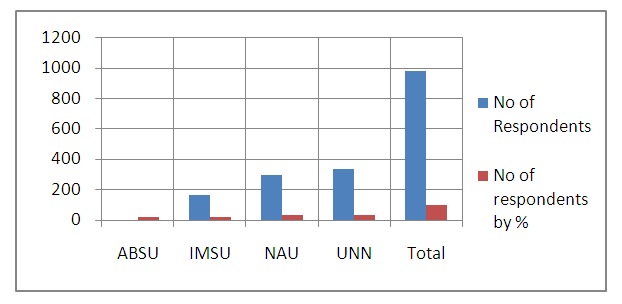 | Figure 1. Respondents by Institution |
|
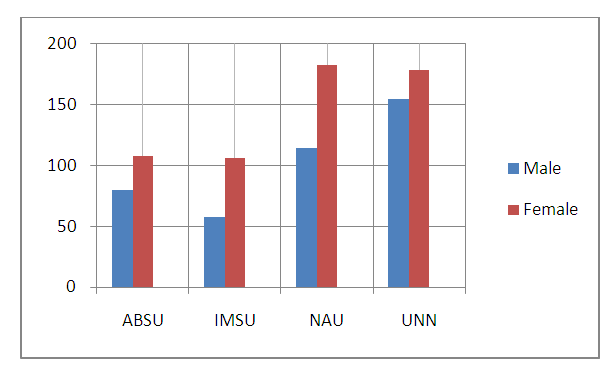 | Figure 2. Respondents by Gender |
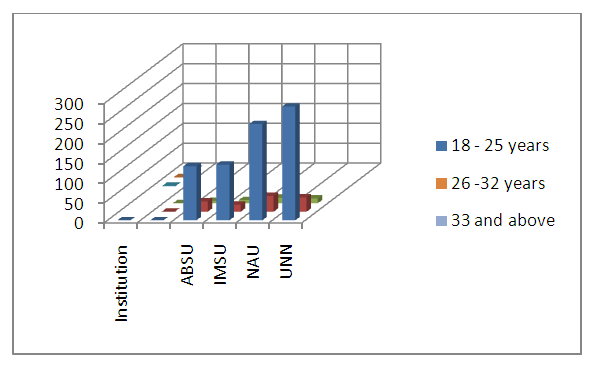 | Figure 3. Respondents by Age range |
6. Data Analysis and Discussion of Result
- This section presents and discusses results of the study focusing on current library and information science educational procedure in SE Nigeria as to determining how it holistically prepare potential librarians towards the changes that are taking place in our academic environment and the world.Research Question 1:What educational processes are being used in training LIS students in SE Nigeria?Table 2, shows that 524 (53.3%) of the respondents strongly agree and another 400 (40.8%) agree that the teaching process allows for full participation and question asking, while the remaining 56 (5.8%) disagree. A total of 764 (78%) respondents indicate that the course contents are theory based with little or no practical classes, while 800 respondents representing 82% discontent that Indexing and abstracting involve practical whereas 705 0r 684 respondents affirm that there are no practical classes on information literacy skills. The same number that affirm that Students are not allowed to rate lecturers at the end of each course offered. On the area of practical classes on digitization of information resources, 79% 0r 872 indicate that there are no practical classes.
|
|
|
|
7. Conclusions and Recommendations
- This study exposes the fact that LIS education programmes in SE Nigeria have to some degree, responded to the call for a transformation in LISE but the level of understanding of LISE in by the students still left much to be desired. On the other hand, that the LIS education in this region are faced with many challenges which are bound to work against the purpose of using LISE as a means of preparing potential librarians to be relevant in a changing world. They include; improper teaching methods, lack of educational infrastructure and equipment, students not taught most of the emerging topics in line with global trends as a result of the birth of ICT and changing world that is ruled by information as well as poor evaluation methods of students. The above opinion is also shared by Katuli-Munyoro and Mutula (2017) as they declared that LIS professional competencies and skills must evolve continuously in order to remain relevant in the contemporary world. The data suggest that today’s LIS educators have not mastered the required competencies and are not able to transfer these successfully to their students. The study leaves no one in doubt as to the necessity for LIS educators and practitioners to adopt a position of continuously learning and relearning to keep up to date. In view of the above, and if would be librarians would stand the test of time and be relevant in a daily changing information age there must be a paradigm shift. As a way forward therefore, the researcher is of the opinion that the following measures should be applied as remedies:v It is high time NUC and LRCN arose to their constitutional mandate and responsibilities as quality assurance agencies responsible for the reviewing of LIS curricula, accreditation of library schools and enforcement of standards. They should work as to avoiding the temptation of ‘brown envelope’ (The name that Nigerians christened high profile bribery) which in most cases are valued at the detriment of standard and excellence. The underlined factor here is that NUC should give accreditation to LIS schools only when such school is found to have all the pre-requisite which include: human capacity, necessary infrastructure and equipment. These two agencies should partner to ensure regular review of LIS curricula in line with what are obtained in advanced nations in accordance with the standards stipulated by International Federation of Library Associations (IFLA) and Chartered Institute of Library and Information Professionals (CILIP) in an information age. v The heads of LIS schools need to adopt aggressive and assertive approach to ensuring that the desired change in the education of information professionals is achieved. LIS schools need to apply innovative management principles to harness the products, process, and services or operations within the department and host institution. Although, the professional knowledge base of librarians or LIS educators is highly important in the transformation of LISE, obviously, management skills cannot be overemphasized in reaching high-level performance.v LIS schools need to critically assess the ethical issues arising from the information cycle within their environment and develop ethical codes alongside with the standards ones for effectiveness and efficiency. The changes in information system brought by different technologies must be a guiding factor. As noted by Mabawonku (2011), the essence of ethical code is to resolve conflicting interests within the information cycle, and harmonize the interests of information providers with those of information users. Consequently, LIS schools in SE Nigeria need to include in their curriculum, course(s) that would not only equip the students with knowledge of best practices for the profession but also with the ability to educate the government, policy makers, and other stakeholders on the value of maintaining ethics in providing, accessing and using information for decision making, self and national developments.v In the words of Akwang (2017), LIS schools in Nigeria need to partner other schools within the country, developing countries and in the developed world as to bringing about innovation and transformation in many areas of LISE. The areas include teaching, research, curriculum development, knowledge sharing, students’ industrial training, oral examination, exchange programmes among others. v Education and training of staff is one of the most critical ingredients for improved organizational performance (Sivadas, 2012). Considering the technological advancement and changes in the teaching environment, process, and strategies, staff who are drivers of the change must receive some level of education and be continuously trained. Resis In Johnson (2012) affirmed that all activities of any institution are initiated and determined by the persons that make up the institution. That means, the available school plants, equipment, computer systems, and all other facilities are unproductive except for human efforts and directions. Therefore, members of staff need to be technically and socially competent to perform adequately on a given task or job. The view is that training and re-training the trainers is a sine-qua-non if their products are to be relevant in the scheme of the changing world.v LIS practitioners will have to be provided with the knowledge and functional skills to use and manipulate these and future technological innovations for up-to-date service delivery and for true professionalism. It appears that traditional professional competencies, skills, techniques and technologies of LIS practitioners have been overtaken by modern technological requirements. LIS education and training programmes are challenged by the need to respond to new demands. The suggestion is that the LIS educational system has become passé and must be re-engineered so as to regain its relevance as a societal transformation tool.v The various governments under whose jurisdiction falls the funding of these library schools, should stop paying lip service to the provision of educational infrastructure and equipment knowing full well that these amenities act as catalyst to effective teaching and learning. On the other hand, those working as heads of library schools should avoid this Nigerian factor that every appointment is an avenue to misappropriate fund and enrich one-self and associates. Apart from judicious use of fund allotted for the development of these library schools, the heads ought to embrace proper maintenance culture and ensure that infrastructure and educational equipment under their care are well maintained and taken good care of.v Heads of Library and Information Science Departments should as a matter of necessity ensure the inclusion of practical sessions in the teaching of topics like: indexing; abstracting, information literacy in a digital age, digitalization; database management, cataloguing and classification among others.v The NUC and LRCN should devise different forms of summative and formative evaluation methods for LIS students putting into consideration the three domains of knowledge in which case, students’ conceptual, synthesis and application skills in library and information science will be tested. In fact, the agencies should come with external independent periodic assessment of internal education quality assurance at LIS schools to be conducted by tested and reliable professionals designated ‘a body’.v Furthermore, evaluation being a cooperative process means that both teachers and learners are all interested parties; to this end, there must be a policy (which will be part of the educational system) which allows the students to assess their lecturers after classes after all, the whole idea of evaluation is to provide information about someone’s work with a view to improving it in case there are loopholes. Let us make hay while the sun shines and make librarianship the envy of all.
 Abstract
Abstract Reference
Reference Full-Text PDF
Full-Text PDF Full-text HTML
Full-text HTML

